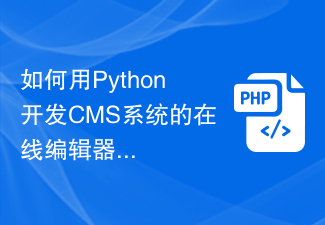 Java
Java javaTutorial
javaTutorial How to use Java to develop the site domain name registration function of CMS system
How to use Java to develop the site domain name registration function of CMS systemHow to use Java to develop the site domain name registration function of the CMS system
Introduction:
With the development of the Internet, more and more websites are created, and each website needs to be registered. Legal business qualifications. When developing a CMS system, providing domain name registration functions for sites is one of the very important requirements. This article will introduce how to use Java to develop the site domain name registration function of the CMS system and provide corresponding code examples.
1. Build the CMS system framework
First, we need to build a basic CMS system framework. This can be achieved by using Spring Boot and MVC framework. The following is a simple code example:
@SpringBootApplication
public class CmsSystemApplication {
public static void main(String[] args) {
SpringApplication.run(CmsSystemApplication.class, args);
}
}
@Controller
public class SiteController {
@GetMapping("/site/{siteId}/domain")
public String domain(@PathVariable("siteId") String siteId, Model model) {
// TODO: 返回站点域名备案页面
return "domain_record";
}
@PostMapping("/site/{siteId}/domain")
public String recordDomain(@PathVariable("siteId") String siteId, @RequestParam("domain") String domain, Model model) {
// TODO: 备案提交逻辑
return "record_success";
}
} 2. Design the site domain name registration page
Next, we need to design a site domain name registration page for users to fill in the registration information. On this page, users need to fill in relevant information such as the site domain name and submit a filing application. The following is a simplified HTML page example:
<!DOCTYPE html>
<html lang="en">
<head>
<meta charset="UTF-8">
<title>站点域名备案</title>
</head>
<body>
<h1 id="站点域名备案">站点域名备案</h1>
<form action="/site/{siteId}/domain" method="post">
<label for="domain">域名:</label>
<input type="text" id="domain" name="domain" required>
<br>
<input type="submit" value="备案">
</form>
</body>
</html>3. Implement the filing and submission logic
When the user clicks the filing and submitting button, we need to implement the corresponding filing and submission logic. Generally speaking, the filing information filled in by users needs to be called to the filing system through the interface for verification and review. In actual development, we can complete this step by calling the third-party registration interface. The following is a simplified code example:
@Service
public class RecordService {
@Autowired
private RestTemplate restTemplate;
public boolean submitRecord(String siteId, String domain) {
// 构造备案提交的参数
Map<String, String> params = new HashMap<>();
params.put("siteId", siteId);
params.put("domain", domain);
// 调用备案接口提交备案申请
String recordUrl = "http://record-api.com/submit";
ResponseEntity<String> responseEntity = restTemplate.postForEntity(recordUrl, params, String.class);
// 解析备案接口的响应结果
String result = responseEntity.getBody();
// TODO: 解析结果判断备案是否成功
return true; // 假设备案成功
}
}4. Front-end and back-end interaction
The last step is to implement the interaction logic of the front-end and back-end. When the user clicks the filing submit button, the front-end page will send the filled-in information to the server through a POST request, and the server will call the filing interface for filing verification and submission. Here is a simplified example of the interaction between the front-end page and the back-end controller:
Front-end page:
<script>
function submitRecord() {
var domain = document.getElementById('domain').value;
var xhr = new XMLHttpRequest();
xhr.open('POST', '/site/{siteId}/domain', true);
xhr.setRequestHeader('Content-Type', 'application/x-www-form-urlencoded');
xhr.onreadystatechange = function() {
if (xhr.readyState === 4 && xhr.status === 200) {
// TODO: 备案成功后的处理逻辑
alert('备案成功!');
}
};
xhr.send('domain=' + encodeURIComponent(domain));
}
</script>
<form>
<!-- ... -->
<input type="submit" value="备案" onclick="submitRecord()">
</form>Back-end controller:
@Controller
public class SiteController {
@Autowired
private RecordService recordService;
@PostMapping("/site/{siteId}/domain")
public String recordDomain(@PathVariable("siteId") String siteId, @RequestParam("domain") String domain, Model model) {
boolean success = recordService.submitRecord(siteId, domain);
if (success) {
return "record_success";
} else {
return "record_fail";
}
}
} Conclusion:
Passed In the above steps, we have completed the development of the site domain name registration function of the CMS system using Java. By building a framework, designing pages, implementing registration submission logic and front-end and back-end interaction, we can easily implement a simple domain name registration function. Of course, in actual projects, the system needs to be improved and optimized according to specific needs.
The above is the detailed content of How to use Java to develop the site domain name registration function of CMS system. For more information, please follow other related articles on the PHP Chinese website!
 cms系统哪个好?十大开源CMS建站系统【总结推荐】Jul 27, 2022 pm 04:01 PM
cms系统哪个好?十大开源CMS建站系统【总结推荐】Jul 27, 2022 pm 04:01 PM互联网的蓬勃发展,免费且开源的建站系统的层出不穷,而我们经常在网上看见有人问及”哪个CMS系统最好用”、”企业建站用哪个CMS系统最多”等类似问题。下面PHP中文网就来给大家总结分享十大开源CMS建站系统,排名不分先后,一起来看看吧!
 帝国cms管理员在哪个表Feb 22, 2023 pm 07:00 PM
帝国cms管理员在哪个表Feb 22, 2023 pm 07:00 PM管理员表有:1、phome_enewsuser,是管理员记录表;2、phome_enewsdolog,是管理员操作记录表;3、phome_enewsgroup,是管理员用户组数据记录表;4、phome_enewslog,是管理员登陆日志;5、phome_enewsloginfail,是管理员登陆失败记录表;6、phome_enewserrorclass,是管理员错误报告记录表。
 如何用Python开发CMS系统的在线编辑器功能Aug 04, 2023 am 09:45 AM
如何用Python开发CMS系统的在线编辑器功能Aug 04, 2023 am 09:45 AM如何用Python开发CMS系统的在线编辑器功能随着互联网的发展,CMS系统成为了许多网站开发者的首选。作为一种内容管理系统,它可以帮助用户轻松创建、编辑和发布网站内容。而在线编辑器功能是CMS系统中一个必不可少的组件,它允许用户在网站上直接编辑并保存内容。本文将介绍如何使用Python开发CMS系统的在线编辑器功能,并提供一些代码示例。在开始之前,我们需要
 帝国cms可以删除模块吗Mar 13, 2023 pm 07:18 PM
帝国cms可以删除模块吗Mar 13, 2023 pm 07:18 PM帝国cms可以删除模块。删除模块的方法:1、登录帝国CMS后台,依次点击“系统”-“系统设置”-“系统参数设置”-“关闭相关功能”,根据自己网站的需求,自行勾选设置来关闭对应的模块功能;2、关闭功能后,删除对应模块的在e目录下的子目录;3、修改e目录下的php文件,在文件第二行加上代码“exit();<?php exit()”,并保存修改即可。
 PHP中的CMS系统开发指南May 21, 2023 pm 02:51 PM
PHP中的CMS系统开发指南May 21, 2023 pm 02:51 PM随着互联网的发展,网站已经成为人们获取信息和交流的重要方式。而为了更好地管理和维护网站内容,CMS(ContentManagementSystem)系统应运而生。作为一种常用的建站工具,CMS系统提供了一种简单、快捷、高效的方式来建立和管理网站。而PHP作为一种强大的后端语言,在CMS系统开发中应用广泛。本文将为大家讲解PHP中的CM
 PHP开发CMS系统完成后如何进行有效的测试Jun 21, 2023 am 10:58 AM
PHP开发CMS系统完成后如何进行有效的测试Jun 21, 2023 am 10:58 AM在日益发展的互联网时代中,CMS系统已经成为了网络建设中的一项重要工具。其中PHP语言开发的CMS系统因其简单易用,自由度高,成为了经典的CMS系统之一。然而,PHP开发CMS系统过程中的测试工作也是至关重要的。只有经过完善、系统的测试工作,我们才可以保证开发出的CMS系统在使用中更加稳定、可靠。那么,如何进行有效的PHP开发CMS系统测试呢?一、测试流程的
 如何用Python编写CMS系统的数据自动清理功能Aug 04, 2023 am 08:13 AM
如何用Python编写CMS系统的数据自动清理功能Aug 04, 2023 am 08:13 AM如何用Python编写CMS系统的数据自动清理功能在现代的CMS(ContentManagementSystem)系统中,数据的积累是不可避免的。随着时间的推移,庞大的数据量可能会导致系统性能下降,并且无用数据的堆积可能会占用服务器的存储空间。因此,为了确保系统的高效运行,我们需要一个数据自动清理功能来定期清理无用数据。Python是一种强大的编程语
 如何用Python搭建CMS系统的主题管理功能Aug 04, 2023 am 10:09 AM
如何用Python搭建CMS系统的主题管理功能Aug 04, 2023 am 10:09 AM如何用Python搭建CMS系统的主题管理功能CMS(内容管理系统)是一种用于管理和发布内容的软件程序。它可以帮助用户创建、编辑和组织各种类型的内容,例如文章、图像和视频等。在一个大型的CMS系统中,主题管理功能十分重要,因为它可以让用户轻松地改变网站的外观和风格,从而满足不同的需求和目标。本文将介绍如何使用Python搭建CMS系统的主题管理功能。我们将使


Hot AI Tools

Undresser.AI Undress
AI-powered app for creating realistic nude photos

AI Clothes Remover
Online AI tool for removing clothes from photos.

Undress AI Tool
Undress images for free

Clothoff.io
AI clothes remover

AI Hentai Generator
Generate AI Hentai for free.

Hot Article

Hot Tools

WebStorm Mac version
Useful JavaScript development tools

SublimeText3 Mac version
God-level code editing software (SublimeText3)

SublimeText3 Chinese version
Chinese version, very easy to use

Safe Exam Browser
Safe Exam Browser is a secure browser environment for taking online exams securely. This software turns any computer into a secure workstation. It controls access to any utility and prevents students from using unauthorized resources.

Dreamweaver Mac version
Visual web development tools






